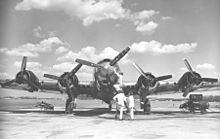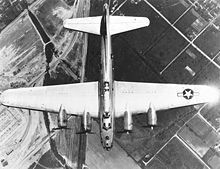From Wikipedia"
The Boeing B-17 Flying Fortress is a four-engine heavy bomber aircraft developed in the 1930s for the United States Army Air Corps (USAAC). Competing against Douglas and Martin for a contract to build 200 bombers, the Boeing entry outperformed both competitors and exceeded the Air Corps' expectations. Although Boeing lost the contract because the prototype crashed, the Air Corps was so impressed with Boeing's design that they ordered 13 more B-17s for further evaluation. From its introduction in 1938, the B-17 Flying Fortress evolved through numerous design advances.
The B-17 was primarily employed by the United States Army Air Forces (USAAF) in the daylight precision strategic bombing campaign of World War II against German industrial and military targets. The United States Eighth Air Force, based at many airfields in southern England, and the Fifteenth Air Force, based in Italy, complemented the RAF Bomber Command's nighttime area bombing in the Combined Bomber Offensive to help secure air superiority over the cities, factories and battlefields of Western Europe in preparation for the invasion of France in 1944. The B-17 also participated to a lesser extent in the War in the Pacific, early in World War II, where it conducted raids against Japanese shipping and airfields.
From its pre-war inception, the USAAC (later, the USAAF) touted the aircraft as a strategic weapon; it was a potent, high-flying, long-range bomber that was able to defend itself, and to return home despite extensive battle damage. Its reputation quickly took on mythic proportions, and widely circulated stories and photos of notable numbers and examples of B-17s surviving battle damage increased its iconic status. With a service ceiling greater than any of its Allied contemporaries, the B-17 established itself as an effective weapons system, dropping more bombs than any other U.S. aircraft in World War II. Of the 1.5 million metric tons of bombs dropped on Germany and its occupied territories by U.S. aircraft, 640,000 tonnes were dropped from B-17s.
As of May 2015, 10 aircraft remain airworthy. None are combat veterans. Additionally a few dozen more in storage or on static display. The oldest is a D Series combat veteran with service in the Pacific and the Caribbean.
On 8 August 1934, the U.S. Army Air Corps (USAAC) tendered a proposal for a multi-engined bomber to replace the Martin B-10. The Air Corps was looking for a bomber capable of reinforcing the air forces in Hawaii, Panama, and Alaska. Requirements were that it would carry a "useful bombload" at an altitude of 10,000 feet (3 km) for 10 hours with a top speed of at least 200 miles per hour (320 km/h).
They also desired, but did not require, a range of 2,000 miles (3,200 km) and a speed of 250 miles per hour (400 km/h). The competition for the Air Corps contract would be decided by a "fly-off" between Boeing's design, the Douglas DB-1, and the Martin Model 146 at Wright Field in Dayton, Ohio.
The prototype B-17, with the Boeing factory designation of Model 299, was designed by a team of engineers led by E. Gifford Emery and Edward Curtis Wells, and was built at Boeing's own expense. It combined features of the experimental Boeing XB-15 bomber with the Boeing 247 transport aircraft. The B-17's armament consisted of up to 4,800 pounds (2,200 kg) of bombs on two racks in the bomb bay behind the cockpit, and initially possessed five 0.30 inches (7.62 mm) machine guns. It was powered by four Pratt & Whitney R-1690 "Hornet" radial engines each producing 750 horsepower (600 kW) at 7,000 feet (2,100 m).
The first flight of the Model 299 was on 28 July 1935 with Boeing chief test-pilot Leslie Tower at the controls. Richard Williams, a reporter for the Seattle Times, coined the name "Flying Fortress" when the Model 299 was rolled out bristling with multiple machine gun installations. The most unusual gun emplacement was the nose installation (see note for description and drawing), which allowed the single machine gun to be fired toward almost any frontal angle that an approaching enemy fighter would take to attack the B-17.
Boeing was quick to see the value of the name and had it trademarked for use. Boeing also claimed in some of the early press releases that Model 299 was the first combat aircraft that could continue its mission if one of its four engines failed. On 20 August 1935, the prototype flew from Seattle to Wright Field in nine hours and three minutes at an average cruising speed of 252 miles per hour (406 km/h), much faster than the competition.
At the fly-off, the four-engine Boeing's performance was superior to those of the twin-engine DB-1 and Model 146. Then-Major General Frank Maxwell Andrews of the GHQ Air Force believed that the long-range capabilities of four-engine large aircraft were more effective than shorter-ranged, twin-engined aircraft, and that the B-17 was better suited to their doctrine. His opinions were shared by the Air Corps procurement officers, and even before the competition had finished they suggested buying 65 B-17s.
Development continued on the Boeing Model 299, and on 30 October 1935, Army Air Corps test-pilot Major Ployer Peter Hill and Boeing employee Les Tower took the Model 299 on a second evaluation flight. The crew forgot to disengage the "gust locks," a system of devices integral to the design that held the bomber's movable control surfaces in place while the aircraft was parked on the ground. After take-off, due to the failure to manually disengage all of the gust locks, the aircraft entered a steep climb, stalled, nosed over, and crashed, killing Hill and Tower (other observers survived with injuries).
The crashed Model 299 could not finish the evaluation and, while the Air Corps was still enthusiastic about the aircraft's potential, Army officials were daunted by the much greater expense per aircraft (Douglas quoted a unit price of $58,200 based on a production order of 220 aircraft, compared with a price of $99,620 from Boeing), and as the competition could not be completed Boeing was legally disqualified from the consideration for the contract. Army Chief of Staff Malin Craig cancelled the order for 65 YB-17s, and ordered 133 of the twin-engine Douglas B-18 Bolo instead.
The loss was not total... but Boeing's hopes for a substantial bomber contract were dashed.
B-17G
The most unusual conversion of the B-17G was the JB-17G converted to an
engine test bed. The nose section was removed and replaced with a
strengthened mount for a fifth engine.
Top view of a B-17G in flight









No comments:
Post a Comment